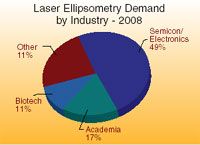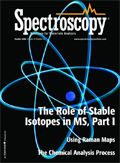Market Profile: Laser Ellipsometry
Ellipsometry is the analysis of the change in the state of polarized light after it has reflected from the surface of a thin film sample. Laser ellipsometry, which has certain advantages and disadvantages, is a subset of this market. Applications for laser ellipsometry prinarily are related to the semiconductor and electronics industry, but its use in the life sciences could offer significant new demand.
Ellipsometry is the analysis of the change in the state of polarized light after it has reflected from the surface of a thin film sample. Laser ellipsometry, which has certain advantages and disadvantages, is a subset of this market. Applications for laser ellipsometry prinarily are related to the semiconductor and electronics industry, but its use in the life sciences could offer significant new demand.

Laser Ellipsometry Demand by Industry - 2008
As the name implies, laser ellipsometers use a laser as the light source, which produces monochromatic or single-wavelength radiation. This contrasts with spectroscopic ellipsometers, which utilize light sources that produce a broad spectrum, and account for a significantly larger market. Laser ellipsometry provides a much faster analysis, and produces a much smaller analysis spot, which makes it better suited for mapping and microscopy applications. One major limitation of laser ellipsometers is that they normally can analyze only single-layer films, although some models add a second and even a third laser source in order to analyze multiple layers.
Laser ellipsometry is used most heavily in the semiconductor and electronics industry. It is suited to analyzing transparent films such as nitrides and oxides, and is used to analyze products such as flat panel displays and solar cells. A potentially large market for laser ellipsometry exists in biotechnology, where scientists are now exploring its use for high-throughput screening of biochips. Laser ellipsometry provides a relatively low-cost, high-speed analysis method that does not require the sample prep associated with fluorescence methods.
The global market for laser ellipsometry is less than $15 million. The next year or two could prove challenging for this market due to the downturn in the semiconductor industry and the consumer economy, although the longer term market potential is still bright.
The foregoing data were based on SDi's market analysis and perspectives report entitled Edition Global Assessment Report, 10th Edition: The Laboratory Life Science and Analytical Instrument Industry, September 2008. For more information, contact Stuart Press, Vice President — Strategic Analysis, Strategic Directions International, Inc., 6242 Westchester Parkway, Suite 100, Los Angeles, CA 90045, (310) 641-4982, fax: (310) 641-8851, www.strategic-directions.com.

LIBS System Built on Microjoule High PRF Laser Identifies Aluminum Alloys for Recycling Potential
January 2nd 2024Differing grades of aluminum alloys have large differences in their composition, especially when it comes to trace elements, emphasizing the need for them to be evaluated for means of production, use, and recycling.